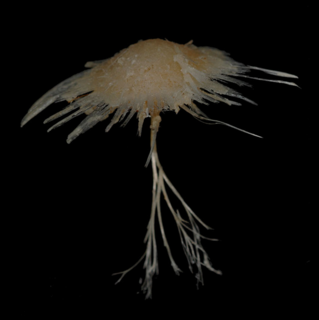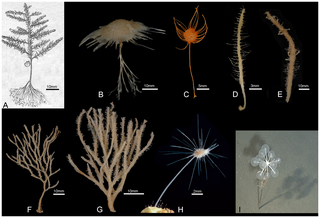
Sponges, the members of the phylum Porifera, are a basal animal clade as a sister of the diploblasts. They are multicellular organisms that have bodies full of pores and channels allowing water to circulate through them, consisting of jelly-like mesohyl sandwiched between two thin layers of cells.

Cladorhiza is a genus of carnivorous sponges, comprising around 40 species found in oceans around the world. Cladorhiza is the type genus of the family Cladorhizidae.

Chondrocladia is a genus of carnivorous demosponges of the family Cladorhizidae. Neocladia was long considered a junior synonym, but has recently become accepted as a distinct genus.
The greater melampitta is a species of bird in the family Melampittidae. It is the only species in the genus Megalampitta, although it was once placed in the genus Melampitta with the lesser melampitta. Formerly classified as a bird-of-paradise, the little-known greater melampitta has an uncertain taxonomy and is sometimes believed to be affiliated to pitohuis, as it appears to be poisonous to eat . It is found in New Guinea. Its natural habitats are subtropical or tropical moist lowland forests and subtropical or tropical moist montane forests.

A giant isopod is any of the almost 20 species of large isopods in the genus Bathynomus. They are abundant in the cold, deep waters of the Atlantic, Pacific, and Indian Oceans. Bathynomus giganteus, the species upon which the generitype is based, is often considered the largest isopod in the world, though other comparably poorly known species of Bathynomus may reach a similar size. The giant isopods are noted for their resemblance to the much smaller common woodlouse, to which they are related.

Chondrocladia turbiformis is a recently discovered species of carnivorous sponge.

Poecilosclerida is an order of the demosponge class. It is the most speciose demosponge order with over 2200 species. It contains about 25 recognised families. They are characterised by having chelae microscleres, that is, the minute spicules scattered through the tissues, usually in the 10-60 μm range, have a shovel-like structure on the end.

Lophiodes is a genus of goosefishes. It is one of four extant genera in the family Lophiidae.

Chondrocladia lyra, also known as the lyre sponge or harp sponge, is a species of carnivorous deep-sea sponge first discovered off the Californian coast living at depths of 10,800–11,500 feet (3,300–3,500 m) by Welton L. Lee, Henry M Reiswig, William C. Austin, and Lonny Lundsten from the Monterey Bay Aquarium Research Institute (MBARI).

Cladorhizidae is a family of demosponges which are carnivorous and prey on crustaceans and other small animals. They are deep sea sponges typically found on oceanic ridges and seamount systems. As of 2017, nine new species have been discovered in the Southwest Indian Ocean Ridge (SWIOR) including: Abyssocladia boletiphora, Ab. corniculiphora, Ab. hemiradiata, Asbestopluma (Asbestopluma) unguiferata, As. (A.) jamescooki, As. (A.) laminachela, As. (A.) pseudoisochela, As. (A.) ramuscula and Chondrocladia (Meliiderma) rogersi.
Cladorhiza caillieti is a carnivorous sponge of the family Cladorhizidae described in 2014 from specimens collected from the Juan de Fuca Ridge off the coast of Vancouver Island. It feeds on small crustaceans such as amphipods and copepods. C. caillieti is an elongate, bottlebrush-shaped sponge with filaments projecting from a main stem, and ranges from 7 to 9 cm in height. The specific epithet honors Dr. Gregor M. Cailliet of the Moss Landing Marine Laboratories.
Gregor Michel Cailliet is an American scientist who studies the ecology of marine fishes. He is professor emeritus at Moss Landing Marine Laboratories, part of The California State University, having officially retired in 2009.
Eurycea subfluvicola, commonly known as the Ouachita streambed salamander, is a species of salamanders found within the Slunger creek valley in Lake Catherine State Park, Arkansas. The species is paedomorphic. The species' scientific name derives from "sub" (below), "fluvius" (stream), and "colo".
The Suwannee snapping turtle is a species of very large freshwater turtle in the family Chelydridae. This species is endemic to the southeastern United States, where it only inhabits the Suwannee River basin.
The Apalachicola snapping turtle is a proposed species that lives in the Apalachicola River, United States. It has traditionally been included as part of the widespread species M. temminckii, but an analysis in 2014 recommended treating it as distinct. A study published the following year considered this change unwarranted and recommended that M. apalachicolae should be considered a junior synonym of M. temminckii, and this is followed by the Reptile Database, IUCN's Tortoise and Freshwater Turtle Specialist Group, and the Committee On Standard English And Scientific Names.

Spiculosiphon oceana is a giant species of foraminifera. Its appearance and lifestyle mimics that of a sponge. It was discovered in 2013 in underwater caves 30 miles off the coast of Spain.
Jean Vacelet is a French marine biologist who specialises in the underwater fauna of the Mediterranean. After earning his licence at the Faculté des Sciences de Marseille and learning to dive in 1954, he specialised in the study of sponges at the Marine station of Endoume, and there he has stayed faithful to both sponges and place for more than half a century. His research has included all aspects of sponges: taxonomy, habitat, biology, anatomy, their bacterial associations, and their place in the evolution of multi-celled animals. He has studied them not only in the Mediterranean but in the Indian Ocean and the Pacific. Exploration of underwater grottoes, together with Jacques Laborel and Jo Hamelin, revealed the existence of sponges dating from very ancient geological periods and the unexpected existence of carnivorous sponges, and surprisingly, the grottoes in some ways mimicked life at much greater depths.
Guilherme Muricy is a Brazilian invertebrate zoologist, and Professor of Invertebrate Zoology at the National Museum of Brazil. He is a specialist in sponges and has written over 100 papers on the chemistry, the taxonomy of sponges, and the descriptions of many new sponge species.
Michelle Kelly, also known as Michelle Kelly-Borges, is a New Zealand scientist who specialises in sponges, their chemistry, their evolution, taxonomy, systematics, and ecology.

Abyssocladia is a genus of the family Cladorhizidae, a family of carnivorous sponges. It is made up of at least 39 species found in oceans all over the world.










